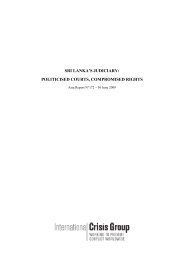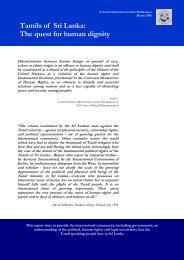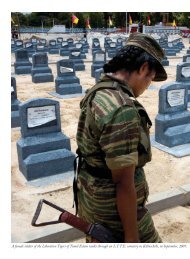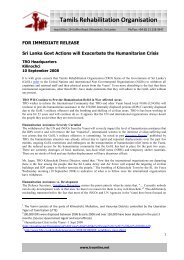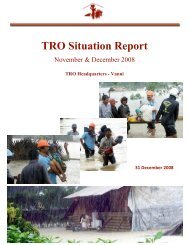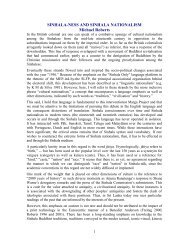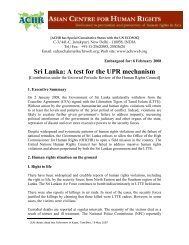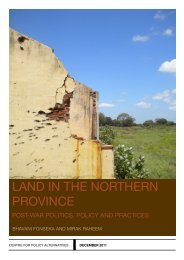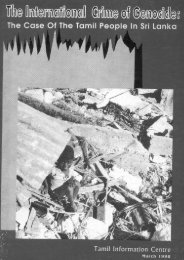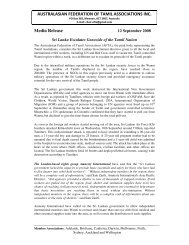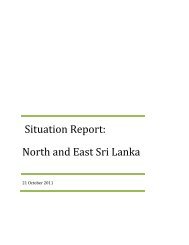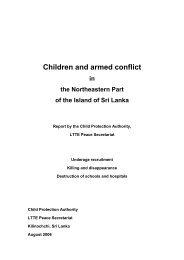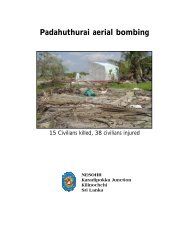You also want an ePaper? Increase the reach of your titles
YUMPU automatically turns print PDFs into web optimized ePapers that Google loves.
<strong>Lest</strong> we forget – Massacres of Tamils 1956 2002<br />
property owned by Tamils. The electoral lists helped them to identify Tamil houses.<br />
Some Sinhalese people at great risk to their own safety hid Tamil friends in their<br />
houses.<br />
Several eye witnesses including tourists have reported that the security personnel<br />
looked on as the violence was perpetrated. There are reports that the Army even<br />
threatened Police not to harass the rioters. On Monday 25th of July at 4.00 p.m. the<br />
government imposed curfew and this stayed in force throughout Tuesday the 26th.<br />
It was again imposed on 27th from 4.00 p.m. to 5.00 a.m. In spite of the curfew<br />
attacks on Tamil people continued through out this period.<br />
Rest of the island<br />
The communal violence against Tamils was not restricted to Colombo. Thugs<br />
roamed the city of Kandy looking for Tamils on the streets and in the buses. In<br />
Trincomalee on 26th of July, 200 houses of Tamils were burned. Violence in<br />
Trincomalee town has been continuing for over a month by the time the violence<br />
broke out in Colombo on the 23rd of July. The Trincomalee town has a Sri Lankan<br />
naval base. The violence against Tamils here was assisted by Sri Lankan Navy as<br />
well as the Army and the Police. In Jaffna on the 23rd of July, the Army went on a<br />
rampage shooting, on the road, in the houses and in buses killing a total of 50<br />
civilians.<br />
<strong>We</strong>likade prison massacre<br />
On 25th July Sinhala prisoners attacked and murdered 35 Tamil detainees in a<br />
section of the <strong>We</strong>likade prison in Colombo. Another 28 Tamil detainees in a<br />
different section was immediately transferred to the Youth Ward. On the 27th<br />
armed Sinhala prisoners scaled the walls and appeared in front of the Youth Ward.<br />
Dr. Rajasundaram respected for his tireless work among the downtrodden sections<br />
of the Tamil community was one of the detainees in the Youth ward. He came<br />
forward and pleaded with the attackers to spare them. Door suddenly opened and<br />
Dr Rajasundaram was dragged out and beaten to death. The rest of the detainees<br />
broke the chairs and tables and used it to keep the attackers at bay.<br />
ICJ report<br />
International Commission of Jurists issued a report on the pogrom. It was written by<br />
Paul Sieghart. This report suggests that the riots of July 1983 began even before the<br />
reports of the killing of 13 Sri Lankan soldiers in a claymore attack in Jaffna<br />
appeared in the local newspapers.<br />
Only on the fifth day, on 28th July the President of Sri Lanka appeared on<br />
television. In a brief address he blamed the violence and destruction exclusively on<br />
the reaction of "the Sinhala people" to the movement for the establishment of a<br />
separate Tamil state, and announced the Cabinet decision to bring in what in the<br />
event became the Sixth Amendment to the country's constitution.<br />
Following is from Paul Sieghart's report,<br />
``In his address to the nation on the 5th day of rioting president did not see it fit to<br />
utter one single word of sympathy for the victims of the violence and destruction<br />
which he lamented. If his concern was to reestablish communal harmony in the<br />
Report by NESOHR,<br />
Information Collected by SNE<br />
6



